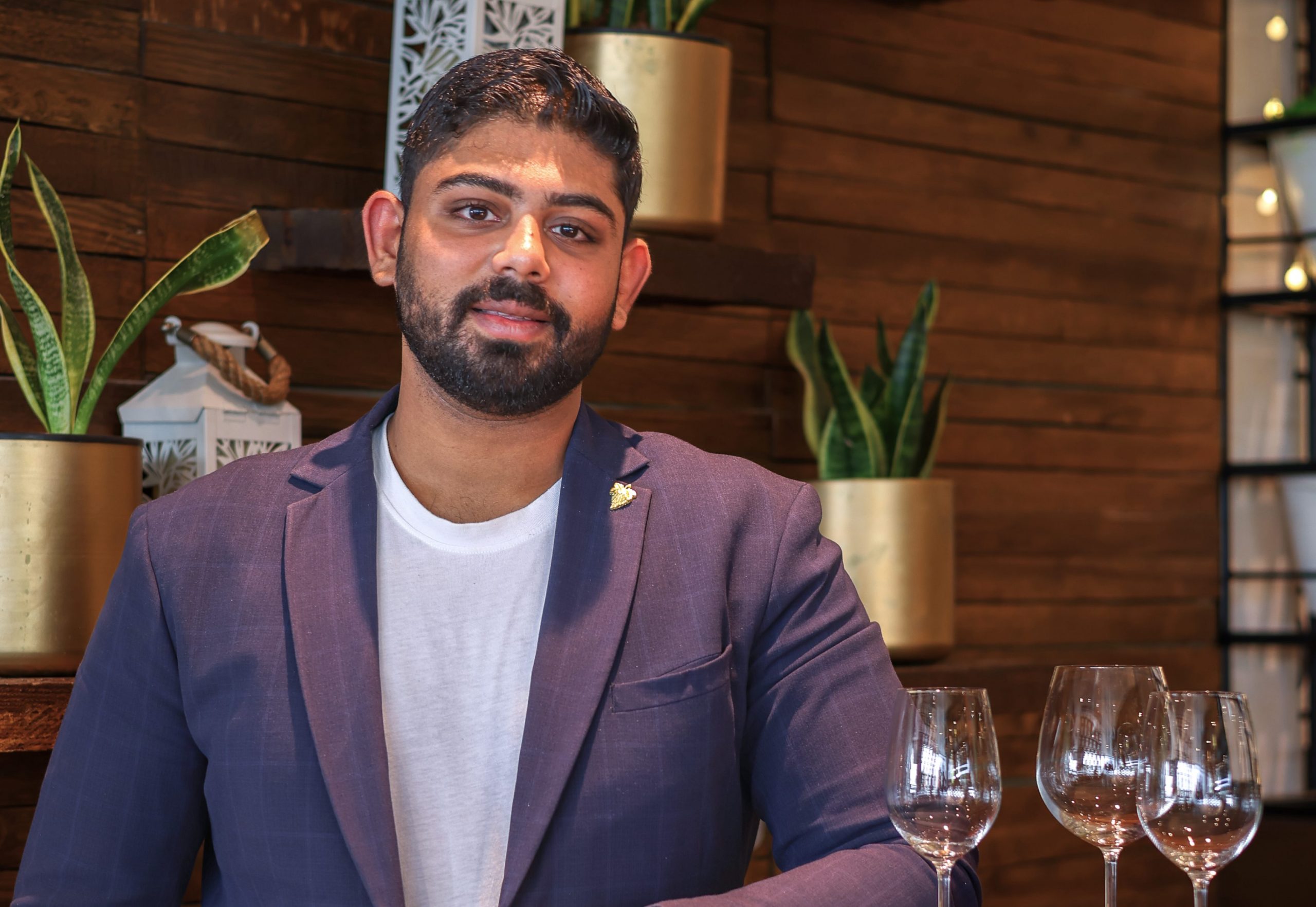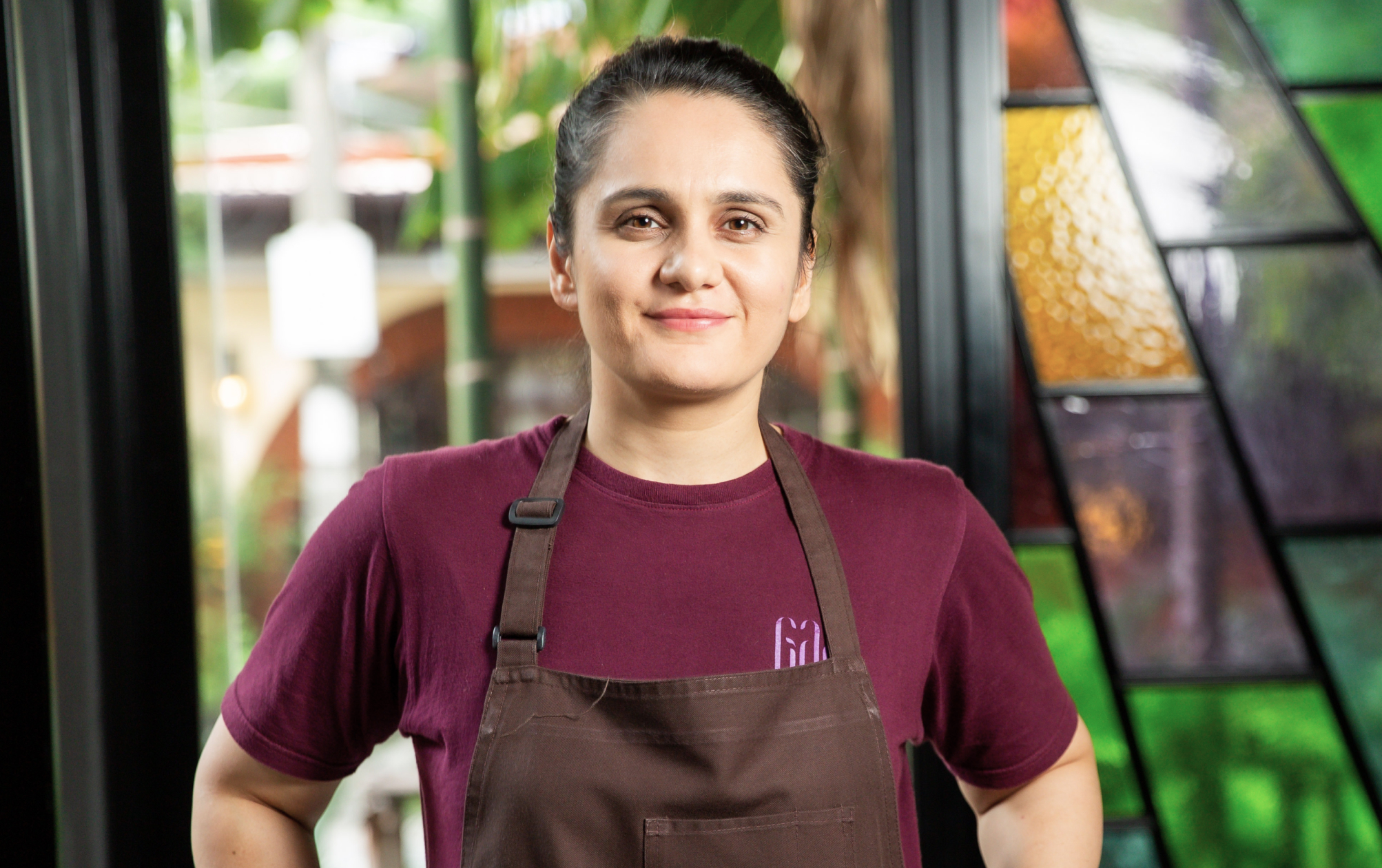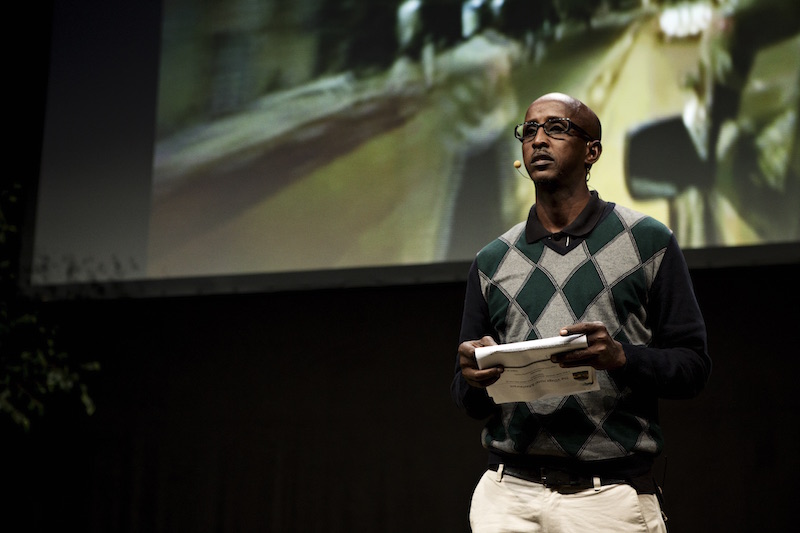Chefs, Spheres, and The Coming Robot Revolution
Toward the end of their presentation at this year´s Madrid Fusion, the chefs of Barcelona’s Disfrutar, which got its third Michelin star a few months ago, finally turned to the hulk silently lurking downstage. Whisking aside the cloth draped over it with a dramatic flourish, Eduard Xatruch and Oriol Castro revealed three microwave-sized machines. When Xatruch pressed a series of buttons, the machines’ lights flashed on and a progress tracker zoomed to life. Seconds later, a perfectly round white ball plopped, like an egg emerging from some kind of futuristic hen, into an attached tub of water. These were spherifications, and the machine, a new invention that will be available this summer under the name Esferiko, could make several of them in less time than it takes to read this paragraph.
The automated kitchen has been a regular feature in science fiction for pretty much as long as science fiction has existed. And of course, robotic machines like the Thermomix have been cluttering up countertops for decades. But we’re now at a point where the technology of automation is poised to fundamentally alter the way we both practice and perceive of cooking itself. And as the Esferiko suggests, that raises big questions about what it means for the people doing it. Including, not least of all, chefs.
“When I talk to people in Silicon Valley who create this sort of technology and who are trying to implement it in restaurants,” says Daniel Story, assistant professor of philosophy at California Polytechnic University, “They say they expect that in 20 or 30 years, no one will be cooking anymore.”
The signs of upheaval reach up and down the food chain, from agriculture to production to the dining room. Just last week, a small company in southern Sweden called Osterlensaffran launched a robot that can harvest saffron, one of the most delicate–and expensive–foods in the world. The company Miso Robotics has created a robot, with the unfortunate name of Flippy, that fries off potatoes and chicken nuggets. Kernel, a vegan restaurant created by Steve Ells, the founder of Chipotle, opened its first semi-automated outlet, with a roboticized arm to do much of the cooking and an entirely online ordering system, in New York last month. Ells plans to open ten more Kernels around the United States in the next couple of years.
At least one study has found food service to be the industry with the highest percentage of tasks suited for automation, which raises the possibility that even more than other professions, hospitality may be looking at a workerless future. (Whether you consider that a good thing or a bad thing may depend on whether you’ve tried to hire a line cook lately).
But beyond the quantitative impact–how many workers the robots will replace— it’s also worth thinking about the qualitative effects, especially in the upper echelons of the industry. After all, one of the hallmarks of fine dining is the massive amount of painstaking and often tedious work that goes into a dish well before it gets anywhere near the diner’s mouth. Spherifications are one example of this kind of labor, but so too are those crisp little cornets filled with salmon roe, and fruit leather beetles, and teeny tiny dots of creamed cauliflower piped in perfectly spaced concentric circles. This kind of insanely meticulous, time-consuming work has historically helped explain why chef hours are so long and has kept small armies of stagiaires employed (if not always paid). It is also taken as a hallmark of the chef’s craft. So what does it mean if chefs no longer have to do it?
The Taste of Robot
All restaurants serve labor. That’s why, after all, many people eat out: so they don’t have to do the work themselves. And much of the work, whether it’s flipping burgers in a fast food joint, or plating salads in a bistro, or tweezing herbs at perfect 45 degree angles to the edge of a clam shell in Michelin-starred temple, is repetitive and mechanical. Yet as you move up the spectrum of dining, even the mechanical labor intensifies– the tasks not only become more intricate and precise, they also require more time and more hands to pull them off. This is what we call craft: the ability to execute a task, by hand, to the highest standards, over and over.
For the diner, knowing that a meal requires craft can be part of the enjoyment, and so when that connection is severed, their pleasure may be diminished. “A lot of the aesthetic or gustatory value of food has to do with beliefs that the eater has about where it came from or how it was made,” says Story, who studies the ways that cognitive factors influence experience. “An extensive regime of culinary automation might undermine that–and basically lead to a disconnect between eaters and the production of food.”
If automation actually removes some of the negative cognitive factors associated with food, however, it could also go the other way. “In the US I always feel a bit bad about eating fast food because I know it was probably made by exploiting workers or paying them a tiny amount of money,” Story says. “If I knew that my burger was made by a robot instead, it might actually improve my experience.”
But if automation has the potential to change the diner’s relationship to food, it has an even greater impact–both quantitatively and qualitatively— on the people making and serving it. Which is why the Esferiko makes such an interesting test case.
The Spherifying Robot
Spherification is a technique that transforms liquids into semi-solids. Invented in an industrial context, it was adopted by elBulli to the fine dining kitchen, and used to create some of the Spanish restaurant’s most iconic dishes, like the spherified olive (a single, normal-looking olive that exploded in a torrent of olive juice when you bit into it).
To create a spherification, a base liquid is mixed with sodium alginate, and then carefully squeezed—often through a syringe—into a calcium bath, where a thin skin forms around each drop. It’s a painstaking job: each drop has to be perfectly sized and timed, since the longer the sphere remains in the bath, the thicker the outer membrane becomes. For a restaurant like Disfrutar, which currently has three spherifications on its tasting menu, that translates into four cooks spending 3 hours a day piping little balls and scooping them out of a bath.
So when Xatruch and his fellow chefs were approached by Kimi Ridaura, the engineer who invented the Esferiko together with a programmer, they happily signed on consultants. “Spherification isn’t a very complicated technique,” Xatruch explains, “But it’s like frying an egg–you have to know how to do it. When it comes to systematized processes like this one, machines make fewer mistakes than people.”
The patented Esferiko isn’t the first automated spherifier. But it is the first one that can make balls in a variety of sizes, from 10 mm in diameter to 50 mm (other machines can only spherify tiny drops) and the only one that can adjust the thickness of the outer membrane. “Its principal objective is to make a repetitive task easier for the cook,” says Ridaura. “And its primary virtue is that it standardizes the spheres.”
When made by hand, the average spherification has to sit in the calcium bath for 120-130 seconds, and be scooped out precisely at the right moment. With the machine, it takes only 10-15 seconds, and no poor stagiaire needs to anxiously stand watch over them. That reduction in labor is why Ridaura describes the machine as democratizing. “It’s so much work to spherify (by hand) that it’s only a few places with elevated prices that can serve them,” he says. “But with this, restaurants at other levels can bring the same touch to their dishes. The recipes themselves don’t have to be very sophisticated.”
Such as? “If you put the membrane on the thickest setting, you can batter and fry it,” Ridaura adds. “So you could totally make a spherified croqueta.”
Craft and the Robot
Once the current Esferiko prototype is perfected, Xatruch expects that the cooks at Disfrutar will be able to spend the 12 labor hours that are normally devoted to spherifying on more creative work or to reduce there hours altogether–and he therefore sees the machine as part of the move toward better work-life balance. “Gastronomy is changing,” he says. “And we all want to optimize things for our teams.”
At the same time, craft still matters to Xatruch—a lot. “In a fast food restaurant, the personal touch isn’t so important,” he says. “But for those of us working in cocina de autor, we’re basically artisans. The difference between us is like the difference between a factory that churns out plates, and a ceramicist who makes them by hand.”
For Xatruch, there is no conflict between these goals; he sees the Esferiko as a tool in the service of craft rather than a compromise with it. “Let’s say we want to make a pea soup. We could make it by cooking the peas and then grabbing a mortar and pestle, and pureeing the peas by hand. It’ll take me a couple of hours, and the puree isn’t going to come out all that smooth. Or I could cook the peas, toss them in the Thermomix, and in one minute I will have a super smooth puree. Are you going to tell me that because I used a machine that puree is no longer artisanal? When a person has still selected the best peas, and made a good ham stock, and cooked the peas in it properly?”
Still, it’s a fine line. Throughout history, the introduction of new machines–not just Pacojets and Roners, but blenders and even ovens—has made the work of cooking easier without necessarily detracting from the craft associated with it, and in that sense, the Esferiko is no different. But it emerges at a time when other things are. ‘For one, changing attitudes are making some practices, like the old stage system, no longer acceptable. The Esferiko, and other automations to come, may enable a kitchen to maintain the precision techniques that fine dining rests on, even while it does away with unpaid apprenticeships and reduces its workers’ hours. In other words, automations of this sort may help speed the transition to a more equitable workplace.
But there are risks as well, for the Esferiko is but one example of a much more profound technological transformation. The pace and number of developments in automation (to say nothing of AI, but that is a story for another day) make it almost certain that the ways in which we make and consume food—and other things— will change dramatically in the coming years. If a startup like Kernel has already cut the ten workers it normally takes to run a fast casual restaurant down to three, it’s not hard to imagine that number dropping even lower. Will restaurants—even fine dining restaurants— one day consist of a single chef who devises recipes that a team of robots then executes? That would be one way to respond to the shortage of skilled workers.
(There’s another: a platform called Cloud Chef that records the key indicators of a dish—quantities, temperature, color, etc— as it is being prepared by a skilled chef, then translates that information into a set of automated processes and instructions that can be executed by workers who, quite literally, have no idea of how to cook. Want to freak yourself out? Watch a robot overlord tell an untrained cook when to flip the steaks).
So here we are. Automation may ease the tedium and effort of human labor in the kitchen, it may make restaurants more profitable and workplaces more equitable. It may make it possible for casual restaurants to incorporate hitherto inaccessible techniques into their repertoire, and spur fine dining places to even greater heights of technical finesse. But for how long will cooking remain a craft? And will something be lost if it is not?
–
Illustration by Sofie Kampmark




